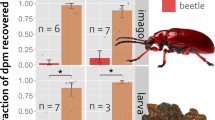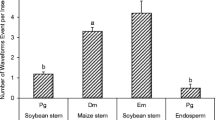Abstract
Regurgitates of the grasshopper Schistocerca americana were deterrent to Crematogaster ants. Regurgitates obtained from insects fed upon wheat seedlings were more strongly deterrent than those obtained from insects fed on romaine lettuce leaves. After extraction of the regurgitates with ethyl acetate, deterrence could be demonstrated in both the organic and aqueous phases. Wheat seedlings, lettuce, and feces from wheat- or lettuce-fed insects yielded extracts with lower deterrency. Our results suggest that deterrents in the organic phase of the regurgitate are primarily due to the presence of plant natural products, whereas the deterrency of the aqueous phase is probably due to digestive enzymes from enteric components, probably digestive enzymes.
Similar content being viewed by others
REFERENCES
Anstee, J. H., and Charnley, A. K. 1977. Effects of frontal ganglion removal and starvation on activity and distribution of six gut enzymes in Locusta. J. Insect Physiol. 23:965-974.
Blum, M. S. 1981. Chemical Defenses of Arthropods. Academic Press, New York.
Bowers, W. S., and Ortego, F. 1991. Evaluation of juvenoid insect growth regulators on Schistocerca americana. Insect Sci. Appl. 12:71-75.
Bowers, W. S., Ortego, F., You, X., and Evans, P. H. 1993. Insect repellents from the Chinese prickly ash Zanthoxylum bungeanum. J. Nat. Prod. 56:935-938.
Curasson, G. 1934. Sur le toxicité de la sécrétion buccale des Sauterelles. Bull. Acad. Vet. Fr. 17:377-382.
Edmunds, M. 1974. Defence in Animals. A Survey of Anti-predator Defenses. Longman, New York.
Eisner, T. 1970. Chemical defense against predation in Arthropods, pp. 157-217, in E. Sondheimer and J. B. Simeone (eds.). Chemical Ecology, Academic Press, New York.
Freeman, M. A. 1967. Proteolytic enzymes of the crop fluid from Locusta migratoria L. Comp. Biochem. Physiol. 20:1013-1015.
Freeman, M. A. 1968. Pharmacological properties of the regurgitated crop fluid of the African migratory locust, Locusta migratoria L. Comp. Biochem. Physiol. 26:1041-1049.
Hinks, C. F., and Erlandson, M. A. 1995. The accumulation of haemolymph proteins and activity of digestive proteinases of grasshoppers (Melanoplus sanguinipes) fed wheat, oats or kochia. J. Insect Physiol. 41:425-433.
Knecht, M., Hagenmaier, H. E., and Zebe, E. 1974. The proteases in the gut of the locust, Locusta migratoria. J. Insect Physiol. 20:461-470.
Lymbery, A., and Bailey, W. 1980. Regurgitation as a possible antipredator defensive mechanism in the grasshopper Goniaea sp. (Acrididae, Orthoptera). J. Aust. Entomol. Soc. 19:129-130.
Matthews, R. W., and Matthews, J. R. 1978. Insect Behavior. Wiley, New York, 507 pp.
Sakal, E., Applebaum, S. W., and Birk, Y. 1988. Purification and characterization of Locusta migratoria chymotrypsin. Int. J. Pept. Protein Res. 32:590-598.
Sakal, E., Applebaum, S. W., and Birk, Y. 1989. Purification and characterization of trypsins from the digestive tract of Locusta migratoria. Int. J. Pept. Protein Res. 34:498-505.
Sakal, E., Applebaum, S. W., and Birk, Y. 1992. Detection and determination of Locusta migratoria trypsin by radioimmunoassay. Arch. Insect Biochem. Physiol. 20:157-164
Steiner, A. L. 1981. Anti-predator strategies. II. Grasshoppers (Orthoptera, Acrididae) attacked by Prionyx parkeri and some Tachysphex wasps (Hymenoptera, Sphecinae and Larrinae): A descriptive study. Psyche 88:1-24.
Wheeler, D. E., and Buck, N. A. 1995. Storage proteins in ants during development and colony founding. J. Insect Physiol. 41:885-894.
Whitman, D. W. 1990. Grasshopper chemical communication, pp. 357-391, in R. F. Chapman and A. Joem (eds.). Biology of Grasshoppers. Wiley-Interscience, New York.
Whitman, D. W., Blum, M. S., and Alsop, D. W. 1990. Allomones: Chemicals for defense, pp. 289-351, in D. L. Evans and J. O. Schmidt (eds.). Insect Defenses. Adaptive Mechanisms and Strategies of Prey and Predators. State University of New York Press, Albany.
Author information
Authors and Affiliations
Rights and permissions
About this article
Cite this article
Ortego, F., Evans, P.H. & Bowers, W.S. Enteric and Plant Derived Deterrents in Regurgitate of American Bird Grasshopper, Schistocerca americana . J Chem Ecol 23, 1941–1950 (1997). https://doi.org/10.1023/B:JOEC.0000006481.86889.78
Issue Date:
DOI: https://doi.org/10.1023/B:JOEC.0000006481.86889.78




